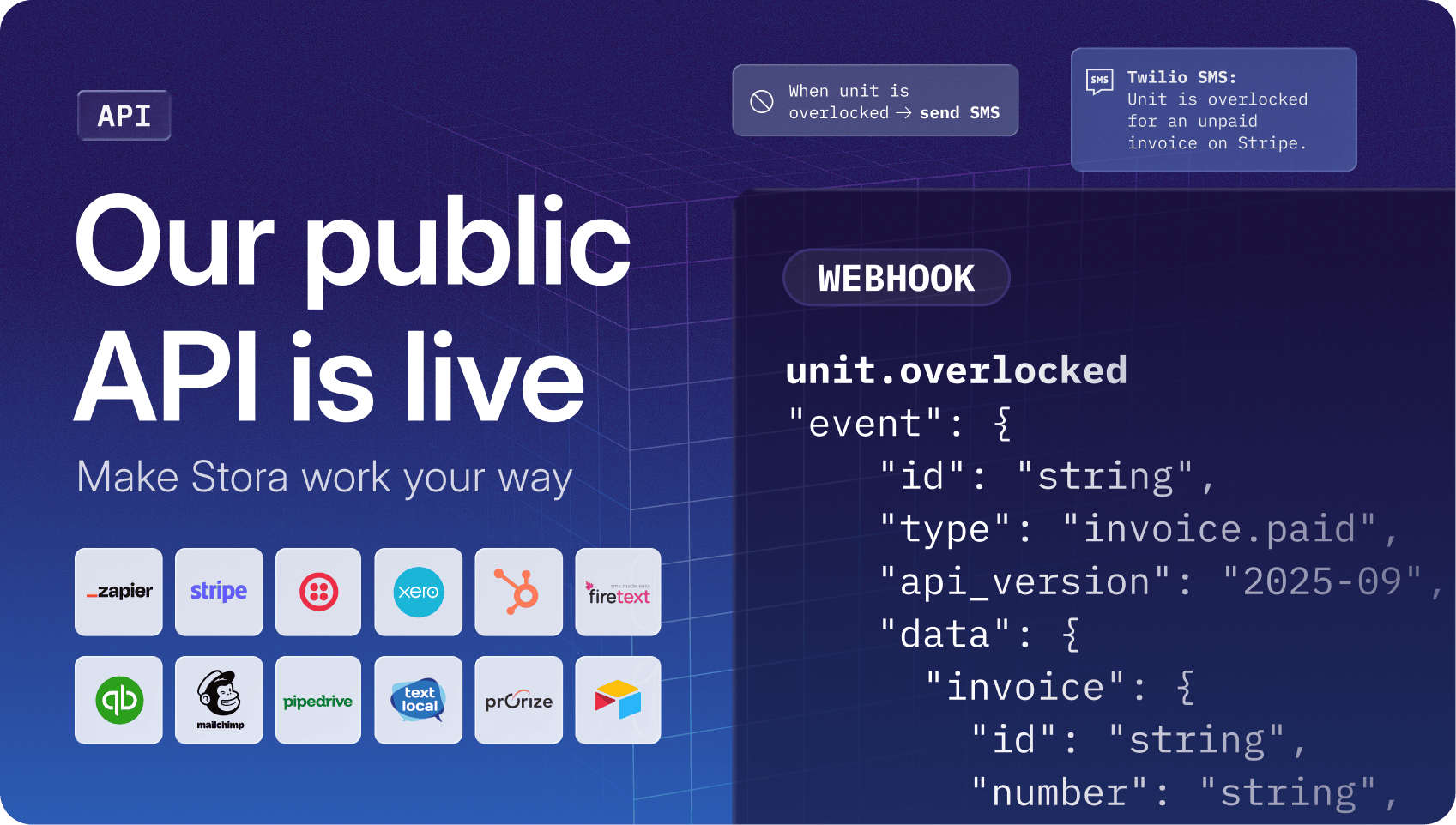Does your website pull in and convert business or drive it away? Your self storage website design might be the culprit. Today, our digital design expert Steven mines his 15+ years' experience to explain the common design mistakes operators make online.
Getting your self storage website design right is a crucial component of your business. Why? Because most potential customers will begin or complete their hunt for a self storage unit on the internet. Hopefully, you’ll be there front and center at the top of search results for them to click through to your website. But to get to the top AND convince them your self storage is the best fit for their needs, there’s work your website needs to do.
Here are some of the common mistakes to avoid with your self storage web design to attract and convert more online visitors into customers.

Not optimizing for mobile
Mobile devices have fast become the predominant starting point for internet users, especially in B2C markets like self storage. At Stora, roughly 70% of our customers' self storage website traffic comes exclusively from mobile phones, and they book and pay via their phone as much as those on desktop computers. If your website is well set up for mobile, you will see most of the customers you acquire online coming from those devices. If it isn’t, you’re doing your business a massive disservice.
How to ensure you’re well set up for mobile
Optimize for small touch screens
Your visitor will be navigating with their fingers, so you ensure buttons and links are large enough to be easily tapped. Also ensure tappable elements aren’t positioned so closely together that it’s hard to select one without accidentally tapping the other.
Ensure it’s a responsive design
The actual website should be designed using responsive web design to ensure it scales nicely to any screen size. By scaling, I mean that when your site loads on different screen sizes (say an iPhone 15 vs a Samsung Z fold), all its elements get bigger or smaller and reflow to fit perfectly. Your pages automatically change width; the layout of photos, graphics, videos, and paragraphs changes; text size increases or decrease so it’s not too tiny to read of so huge that only 3–4 words appear per line, and so on, so everything is readable and tappable.
Consider your content
On your phone you’re usually not looking to read much—you’re scanning for key information that helps you make decisions quickly. So keep your content short and to the point. Break it into small chunks using headings to make things easier to scan. Use images instead of text to get ideas across and make your page less textually dense. Great images will also help you convert, don’t use too many on a single page and keep their file size small. Aim for less than 300 KB images. You can achieve this by reducing dimensions, quality and ensuring you use the correct file type (jpg for photographs, png for not complex images). Why? Site speed, which brings me to my next common mistake in self storage website design.

The website’s too slow
When it comes to online engagement, speed matters. If your website doesn’t load in less than 2 seconds, visitors may bounce before ever seeing its content. In fact, research shows that nearly 70% of consumers admit that page speed impacts their willingness to buy from an online retailer. And every additional second of load time can lose you another 4% in conversion (some research suggests it’s as high as 11%!). What’s more, mobile connections are typically twice as slow as desktop and laptop computer connections, meaning your site needs to be ultra lightweight and fast to load quickly on these devices.
Five seconds to load is considered slow by today’s technology standards and is the threshold where you’ll definitely see high bounce rates as a result. Under three seconds should be your target—as 25% of all visits are abandoned above this threshold, and on mobile, Google says 50% of visits are abandoned if loading takes longer than this. But in truth, well designed websites load in milliseconds, particularly above the fold—that top section of the page that’s visible on the screen before you start to scroll.
However, bounce rates and conversion rates aren’t the only thing page speed impacts. There’s an equally important reason to ensure your site’s blazing fast—search engines. Google, in particular, puts emphasis on page speed in its mobile search algorithm, meaning the faster you are, the more likely you are to rank well. Learn more about the steps you can take to ensure your self storage website runs fast on mobile.

Missing, unclear, or excessive calls-to-action
In website and usability design we have an important north star we orient our work towards and weigh our decisions against: “Don’t make me think”. Everything we do with design, content, and flow is geared to minimizing the brainpower a visitor needs to use in order to complete their goals on our website. Calls-to-action (CTAs) are a key tool in reducing cognitive friction.
Clearly tell visitors what you want them to do, whether it is to reserve a storage unit online, get a quote, contact you for more information, or register for discount offers. Without clear CTAs, visitors may become confused or frustrated and leave your website without taking any action at all.
The right way to design CTAs
Prioritize for context and customer needs
It’s up to you to decide what your calls-to-action should say. I recommend putting yourself in the customer's shoes. What is the job of the page they’re on? Ask yourself why would they be reading that page, and what’s the #1 thing they’d want or expect to be able to do on it? Optimize for that. For example, on a page describing a unit type, the most important CTA is likely to be ‘Book Now’, but on your blog, when visitors are in information-gathering mode instead of a shopping mindset, ‘Book Now’ isn’t as relevant to what they’re doing in that moment as ‘Join Our Mailing List’. If you put your customers first on your website, then you’re doing your best to ensure they get what they need.
Limit the number of CTAs per page
Having too many CTAs on a single page can overwhelm visitors, leaving them unsure of what to click. In design we call this the Paradox of Choice. When presented with too many options, statistics show that people will opt, instead, to choose nothing (or in your case click nothing), which isn’t good for business. So resist the urge to place too many different CTAs on a single page. Multiples of a single CTA, like ‘Book Now’, positioned at important points in the layout is good practice. But ‘Book Now’, and ‘Register for Updates’, and ‘Get a Quote’, and ‘Download Our Guide’, and ‘Request a Call Back’ is too many instructions.
Use design to communicate importance
Good design will differentiate your most important CTAs from your least important ones. In web design we sometimes refer to them as primary, secondary, tertiary and quaternary, etc links. But you can just think of them as first, second, third, and fourth priority links.
Giving each type its own unique design visually helps your visitors understand, at a glance, which are the essential actions you want them to take next, and which are more optional. On websites with light or white backgrounds, primary CTAs typically are buttons with a solid color and light text so that they really pop on screen. Secondary CTAs are usually buttons designed with no fill color but a colored outline and colored text, so they’re lower contrast and more subtle on page. Tertiary CTAs can be simple text hyperlinks, but for sites that need four tiers of CTA design, these might have small visual elements or icons with them—reserving the simple, unadorned text hyperlink for the fourth tier CTA.

Using low-quality images
Humans are visual creatures, so great images can make the difference and help you gain more customers. The images on your website should be clear, of professional quality, and accurately represent your self storage facilities.
You will be judged negatively if photos are badly composed, edited, or blurry. So don’t do it. You’ll also want to think of all your website imagery as one cohesive representation of your business. They should match up in style and help communicate the story of your brand. Don’t, for example, use a mix of color and black and white on your site, or multiple illustration styles.
If you have illustrations or diagrams of self storage units on your website to visualize the size of your units, make sure they effectively communicate the size in a way the viewer can understand at a glance.

Hiding your prices
There’s a rich debate in the self storage industry about whether to show or hide prices on your self storage website. One camp thinks you should hide your prices in order to capture contact details, which are then used to convert a lead into a customer by means such as phone or text. The other camp believes you should let your customers simply see your prices and rent directly online.
At Stora we believe showing prices is the way to go because it puts the customer first. It gives them the information they want without unnecessary interference (plus the option to complete their transaction during that visit when they’re primed to buy), and it frees up staff to be more focused on building awareness of your business or other tasks rather than selling.
If your self storage website can’t convert without first getting someone on the phone, I’d say that indicates there are other issues which need to be solved on your website. Treat your website like your number one salesperson, put the effort in to ensure that it is set up to convert as well as possible, and your business will no doubt reap the rewards.

Being unaware of fixable issues with your website
Speaking of website issues that need to be solved, all too often when a new website is set up, operators neglect to dig into the details of how effectively it’s actually performing the job they need it to do. If a website isn’t performing its function (for you this is most likely acquiring new self storage customers), this can usually be fixed, but first you must be aware of it. Once you are, you can react accordingly, tweaking aspects of your self storage web design or business offering before analyzing whether those changes were successful or not.
How to track performance and act on issues
Track website performance
To gain insight, you first need to make sure an analytics tool has been embedded into your website. That will give you data on activity on your website, such as page views, visitors’ device type, referral sources, and more. The most popular option is Google Analytics, but there are other tools available, such as Plausible Analytics and Simple Analytics. You could take things further and integrate HotJar, which provides you with recordings of your visitors' use of your website and heat maps of where they spend their time on it.
Analyze website data
If you put the effort in to analyze the data these tools provide you, you’ll most likely pick up on usability issues which can be fixed to improve your sales. Look at bounce rates, look at exit pages, look at cart and form abandonment, look at the pathways visitors take on your website. Work out the conversion metrics for each stage of your conversion funnel. What’s working? What’s not?
Keep in mind that analytics data is great for telling you the ‘what’ of what’s going wrong or right. Figuring out the ‘why’ requires you to use your brain, analyze and hypothesize. For example, suppose your data tells you that your homepage bounce rate is 60% (anything over 30% is cause for concern). Then you’d maybe dig deeper and look at the bounce rate to compare the rate for direct traffic vs organic search traffic vs paid traffic. If the bounce rate for direct and organic traffic is 10% but for paid traffic it’s 80%, then that might suggest that the page and its content is a good fit for direct and organic visitors, but that there’s something going on in your ad campaigns that needs looked at. Maybe the search term you’re bidding on is too broad and sending poor quality/poor fit traffic to your site that’s bouncing away cause you’re not actually what they need. Or maybe your homepage isn’t the best destination for that campaign. Perhaps its content doesn’t match up with what you promise in the ad and that’s why folks are bouncing. If bounce rates are high for a page across the board, then evaluate the top culprits that drive bounce: slow page loading, a mismatch between the description in the page meta title and meta description and the actual page content, or the promise in the social post and the page’s actual content (ie, a bait and switch like the search result saying Free XYZ but landing page not immediately reinforcing ‘free’).
Talk to customers
A deeper level of inquiry will return the best results—gathering feedback directly from your customers. This can be done in several ways. You could prompt your visitors or customers to tell you directly on your website via tools like HotJar. But there’s no real substitute for speaking directly to a customer to learn about any issues they had with your website, and why. They have the information you seek, you need to become good at asking them questions in the right way to tease out the answers. I’d recommend reading The Mom Test to help you learn this skill.
Experiment with solutions
Optimizing a website is a process of trial and error. But small, incremental gains here and there will combine into more significant overall improvement over time.
Just make sure you let each change or experiment run for long enough to gather reliable results. Whether you change a headline or shorten a form or add an explainer video, etc, to test an improvement, ensure enough traffic experiences that change for your data to be statistically relevant. If you have a high volume of website traffic, this might only take a week. If your website gets lower traffic, you may want to gather data for a month or two and compare that against the previous period’s data to measure the percentage change.

No self-service for website changes
If your website was designed and built by an agency or freelancer, you may not have a content management system that lets you make changes directly to your website yourself. Instead, you have to go back to them for any change. This has a number of drawbacks:
Delays to critical corrections—Agency or designer availability can hold up simple but urgent fixes that are affecting daily conversions, like typos in your phone number or incorrect hyperlinks.
Delays to optimizations—This availability issue can also mean it takes longer to start work on experimental fixes.
Lengthy feedback loops—Changes take longer to implement because of the inevitable back and forth that occurs when working with others to get both big changes and minor tweaks in place.
Opportunity costs—These back and forths can eat up a surprising amount of your time as an operator.
Financial costs—Having to pay for every change can add up, and can sometimes constrain how many improvements you’re able to make, no matter how necessary.
It’s important that you have the control to make these changes on demand. That’s why your website should be built on top of a platform which lets you edit its content. This could be a general tool such as WordPress or Wix, or something tailored specifically to the self storage industry like the free self storage website template and CMS Stora offers operators with every subscription.
Not only will this control let you make minor corrections quickly and implement and test optimizations faster, but self-service simplifies keeping your website up-to-date. You’ll be able to give the impression that your business is active and ready to welcome new customers. You can regularly update it with new landing pages, new blog posts, and updates to your homepage.
Industry specific tools like Stora’s self storage software will also let you update your unit availability at any time and drive sales with Storefront promotions.
If you can avoid these common mistakes in self storage web design, you’ll increase your chances of acquiring and converting new customers online. Remember that a website is not a one and done deal, it’s a key part of your business that should constantly evolve to fit market demands. Invest the time that it deserves to be in with the best chance of coming out on top and standing out from your competitors.









